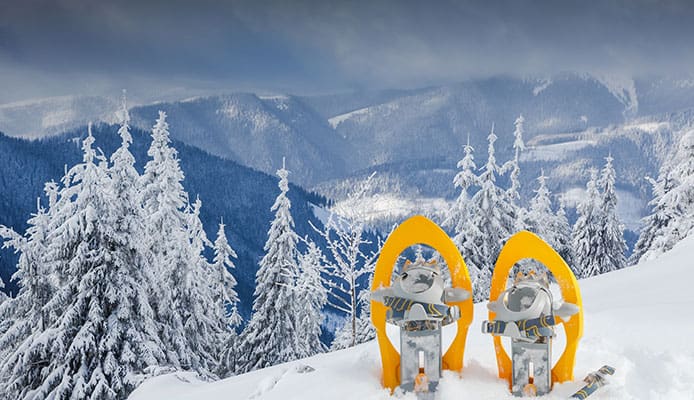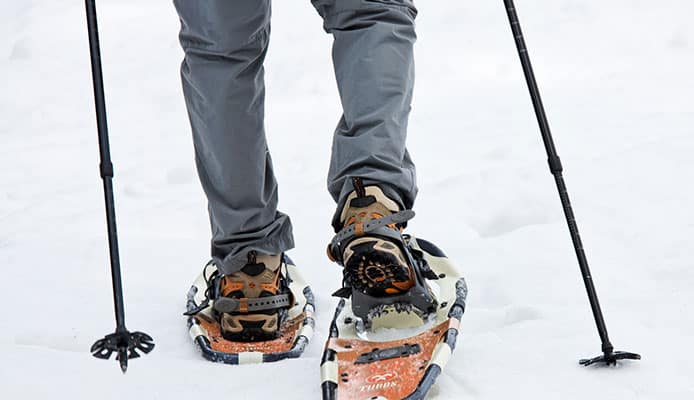
Hiking on freshly fallen snow is one of the best experiences an adventurous person can have. Snowshoeing is generally easy to do. Additionally, it is fairly affordable.
Snowshoes make it possible for you to hike across the snow-covered ground without struggling or falling through the ice. They offer floatation by spreading the weight evenly over a large and flat surface area, giving you the ability to hike, run, or even climb.
When you decide to buy snowshoes, you have to get the snowshoe sizing right. If you buy snowshoes whose size is not ideal for you, you won’t get the right amount of floatation. If you are preparing for an upcoming cold weather hiking trip, read this article before you buy snowshoes. We will help you get the right snowshoe size.
Snowshoe Sizing Factors
1. The Snowshoe Material
The material used to make the snowshoe often influences the sizing. The common snowshoes on the market are made up of either aluminum or composite. The sizes to expect when choosing between these materials are as follows:
- Aluminum-frame snowshoes – These shoes are available in a wide variety of sizes. The most common sizes include 10″ x 36″, 9″ x 30″, and 8″ x 25″.
- Composite snowshoes – These are only available in a single size. You will find them in the size 8″ x 22″. The composite snowshoes, however, offer an option to add tails (up to 6″) to help you remain afloat on soft snow.
2. Gender
Snowshoe sizing is also affected largely by gender. As you would expect, men buy snowshoes capable of accommodating larger hiking boots. When compared to women, most men are generally heavier. This combined with the fact that most men will be carrying a backpacking backpack suggests that their shoes need to have the ability to support heavier loads.
Women snowshoes generally feature narrower and more contoured frame designs. For women, an ideal snowshoe size maybe about 8″ x 21″. The snowshoe binding is generally sized in such a way it only fits hiking boots for women.
3. Age
As you would expect, snowshoes intended for kids will vary depending on the kid’s age. The smaller shoes are generally perfect for casual snow play.
Bigger shoes, however, can accommodate kids hiking boots. They will feature the same technical features as the adult snowshoes.
4. Snowshoe Sizing by Load
Before you buy snowshoes, you should consider the weight you will be carrying. To give you an example, a heavier person will require a bigger snowshoe compared to someone who is not as big.
When considering the weight, you have to consider the weight of the equipment you will be packing in your backpack. For example, if you will be carrying a survival shovel, include it in your weight calculations. Compared to someone who is carrying gear for just a single day, someone carrying gear for a couple of days may need a bigger snowshoe.
5. Snowshoe Sizing by Snow Conditions and Type of Terrain
Generally, the recommended weights you find in online stores are based on light, dry snow conditions. You, however, need to consider the fact that you may need to explore or navigate areas featuring powder snow.
On powder snow, you should be donning bigger snowshoes compared to when exploring areas featuring compact and wet snow. The bigger shoes will improve your ability to stay afloat in the powder snow.
If you will be exploring packed trails, bush, or even a forest, you need to consider the fact that in some instances, you will find yourself in tight spaces. Compact shoes will help you maneuver the tight spaces.
When exploring icy or steep terrain, you should wear smaller snowshoes. Areas featuring deep drifts will need larger snowshoes.
A Step by Step Guide on How to Buy Snowshoes
Now that we have shown you all the factors you need to consider when sizing your snowshoe, we will go ahead and show you the steps you should follow to get the right snowshoes.
1. Weigh the Gear and Backpacks
Weigh the gear bags and backpacks that you intend to carry when you are snowshoeing. Avoid ignoring anything. Weigh even the hiking GPS.
2. Weigh Yourself
Wear your boots, down jacket, and other snowshoe clothes before weighing yourself. If you weigh yourself while donning normal clothing, you will get an erroneous result.
3. Add the Weights
Add the weight you obtained in step 2 above to the weight you had obtained in step 1 above. This is the weight you should use to figure out the ideal snowshoe size for you.
Snowshoes feature both the length and width of the entire shoe in inches. Snowshoe sizing suggestions for different weights are as follows:
- 8 inches by 21 inches snowshoes are ideal for weights ranging between 75 pounds and 140 pounds.
- 8 inches by 25 inches snowshoes are ideal for a weight ranging between 120 pounds and 180 pounds.
- If you find that the total weight ranges between 160 and 220 pounds, you should buy snowshoes featuring a size of approximately 9 inches by 30 inches.
- To support weights exceeding 220 pounds, the best snowshoe should have a size of approximately 10 inches by 36 inches.
Note: Most manufacturers and sellers do have size charts. Before you buy snowshoes, consult the size chart for more precise size recommendations.
4. Consider the Terrain
As mentioned earlier, the terrain where you intend to go winter camping will have a huge influence on the snowshoe sizing. If you figure out that your weight puts you in between 2 possible sizes, you should select the compact, smaller size if you intend to snowshoe in groomed trails or packed snow. If you will be snowshoeing in areas featuring fluffy and powdery snow, invest in the larger snowshoe.
5. Try the Snowshoes
Before you buy the snowshoes, trying them out is always a good idea. You wouldn’t want to pay for the snowshoes only to realize that they are not ideal for you when you are in the snow.
Wear your boots to try the snowshoes. If you just purchased the boots, break in the boots first. After breaking in them, put them on, and proceed to try the snowshoe. Adjust and then tighten the snowshoe bindings. Your feet should stay fixed in place, on your snowshoes.
Note: When testing new snowshoes, adjust the bindings while wearing mittens or hiking gloves. This will allow you to see how easy it is to use the bindings while on the move.
Snowshoe Sizing for Running
Over the years, the popularity of snowshoe running has been increasing. A large number of people are currently discovering the benefits offered by this exercise. For people with joint issues, this exercise usually has much less impact on them. In the majority of the instances, snowshoe running takes place in groomed/packed down terrain.
When it comes to the snowshoe sizing for snowshoes intended for running, one thing to keep in mind is that flotation is not the major focus. The focus is usually on speed. For this reason, to enable a more natural gait, people are interested in running buy snowshoes which are narrower and shorter.
You might also like: Snowshoe Poles
Does Snowshoe Shape Matter?
While this question is extremely important, a large number of people ignore it. Getting the wrong snowshoe shape is as bad as getting the snowshoe sizing wrong.
In the market, you will come across snowshoes featuring 3 major shapes. The shapes are as follows:
- Rectangular
- Elongated oval featuring an elevated or angled front
- Teardrop shape
You will be better off with a snowshoe that balances both the float and maneuverability perfectly. This is generally achieved much better by the tear-drop shape. While the other shapes may still work for you, they may be harder to use compared to the tear-drop shapes.
Globo Surf Overview
Snowshoe sizing can be quite confusing, especially when you are just getting started with snowshoeing. When snowshoeing, the last thing you would want is to walk around carrying more weight than necessary. You wouldn’t want to be stuck with snowshoes you cannot maneuver with easily.
In this article, we have outlined tips to help you buy snowshoes capable of making your snow hike easier. If you understand that smaller shoes are more maneuverable than the larger snowshoes but the larger snowshoes offer better flotation in deeper snow, getting the right snowshoe should be easier.


